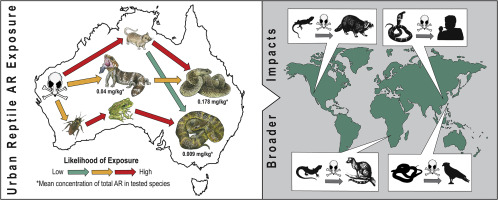当前位置:
X-MOL 学术
›
Sci. Total Environ.
›
论文详情
Our official English website, www.x-mol.net, welcomes your
feedback! (Note: you will need to create a separate account there.)
Toxic time bombs: Frequent detection of anticoagulant rodenticides in urban reptiles at multiple trophic levels.
Science of the Total Environment ( IF 8.2 ) Pub Date : 2020-03-27 , DOI: 10.1016/j.scitotenv.2020.138218 D C Lettoof 1 , M T Lohr 2 , F Busetti 3 , P W Bateman 1 , R A Davis 3
Science of the Total Environment ( IF 8.2 ) Pub Date : 2020-03-27 , DOI: 10.1016/j.scitotenv.2020.138218 D C Lettoof 1 , M T Lohr 2 , F Busetti 3 , P W Bateman 1 , R A Davis 3
Affiliation

|
Anticoagulant rodenticides (ARs) are regularly used around the world to control pest mammals. Second-generation anticoagulant rodenticides (SGARs) are highly persistent in biological tissue and have a high potential for bioaccumulation and biomagnification. Consequently, exposure and poisoning of non-target organisms has been frequently documented, especially in countries with unregulated AR sales and usage. Most of this research has focussed on rodent-predators, usually raptors and predatory mammals, although exposure has also been documented in invertebrates and insectivorous fauna. Few studies have explored non-target exposure in reptiles, despite species sharing similar trophic positions and dietary preferences to other exposed fauna. We tested three abundant urban reptile species in Perth, Western Australia that differ in diet and trophic tiers for multiple AR exposure, the dugite Pseudonaja affinis (rodent-predator), the bobtail Tiliqua rugosa (omnivore) and the tiger snake Notechis scutatus occidentalis (frog-predator). We found frequent exposure in all three species (91% in dugites, 60% in bobtails and 45% in tiger snakes). Mean combined liver concentrations of ARs of exposed individuals were 0.178 mg/kg in dugites, 0.040 mg/kg in bobtails and 0.009 mg/kg in tiger snakes. High exposure frequency and liver concentration was expected for the dugite. Exposure in the other species is more surprising and implies widespread AR contamination of the food web. We discuss the likelihood of global AR exposure of urban reptiles, highlight the potential for reptiles to be important vectors of ARs in the food web and highlight implications for humans consuming wild reptiles.
中文翻译:

有毒定时炸弹:经常在多个营养级检测城市爬行动物中的抗凝血灭鼠剂。
在世界范围内,抗凝杀鼠剂(ARs)经常用于控制害虫哺乳动物。第二代抗凝灭鼠剂(SGAR)在生物组织中具有高度持久性,并且具有很高的生物蓄积和生物放大潜力。因此,经常记录到非目标生物的接触和中毒,尤其是在AR销售和使用不受管制的国家。尽管无脊椎动物和食虫动物也有接触的报道,但大多数研究都集中在啮齿动物-食肉动物上,通常是猛禽和掠食性哺乳动物。尽管物种与其他暴露动物具有相似的营养位置和饮食偏好,但很少有研究探索爬行动物的非目标暴露。我们在珀斯测试了三种丰富的城市爬行动物物种,西澳大利亚州在饮食和营养层次上因多次AR暴露而有所不同,如dugite Pseudonaja affinis(啮齿动物),短尾T Tiliqua rugosa(杂食动物)和老虎蛇Notechis scutatus occidentalis(青蛙捕食者)。我们发现所有三个物种的接触频繁(在dugites中为91%,在短尾猫中为60%,在老虎蛇中为45%)。暴露个体的AR的平均肝总浓度为dugites为0.178 mg / kg,短尾猫为0.040 mg / kg,虎蛇为0.009 mg / kg。辉锰矿的暴露频率和肝脏浓度较高。其他物种的接触更令人惊讶,这意味着食物网中广泛的AR污染。我们讨论了全球爬行类动物AR暴露的可能性,
更新日期:2020-03-27
中文翻译:

有毒定时炸弹:经常在多个营养级检测城市爬行动物中的抗凝血灭鼠剂。
在世界范围内,抗凝杀鼠剂(ARs)经常用于控制害虫哺乳动物。第二代抗凝灭鼠剂(SGAR)在生物组织中具有高度持久性,并且具有很高的生物蓄积和生物放大潜力。因此,经常记录到非目标生物的接触和中毒,尤其是在AR销售和使用不受管制的国家。尽管无脊椎动物和食虫动物也有接触的报道,但大多数研究都集中在啮齿动物-食肉动物上,通常是猛禽和掠食性哺乳动物。尽管物种与其他暴露动物具有相似的营养位置和饮食偏好,但很少有研究探索爬行动物的非目标暴露。我们在珀斯测试了三种丰富的城市爬行动物物种,西澳大利亚州在饮食和营养层次上因多次AR暴露而有所不同,如dugite Pseudonaja affinis(啮齿动物),短尾T Tiliqua rugosa(杂食动物)和老虎蛇Notechis scutatus occidentalis(青蛙捕食者)。我们发现所有三个物种的接触频繁(在dugites中为91%,在短尾猫中为60%,在老虎蛇中为45%)。暴露个体的AR的平均肝总浓度为dugites为0.178 mg / kg,短尾猫为0.040 mg / kg,虎蛇为0.009 mg / kg。辉锰矿的暴露频率和肝脏浓度较高。其他物种的接触更令人惊讶,这意味着食物网中广泛的AR污染。我们讨论了全球爬行类动物AR暴露的可能性,











































 京公网安备 11010802027423号
京公网安备 11010802027423号